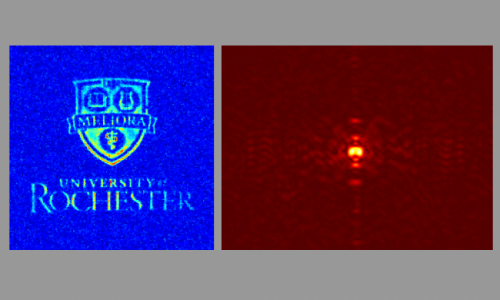'Compressive sensing' provides new approach to measuring a quantum system

(Phys.org) —In quantum physics, momentum and position are an example of conjugate variables. This means they are connected by Heisenberg's Uncertainty Principle, which says that both quantities cannot be simultaneously measured precisely. Recently, researchers have been developing novel techniques, such as "weak measurement," to measure both at the same time. Now University of Rochester physicists have shown that a technique called compressive sensing also offers a way to measure both variables at the same time, without violating the Uncertainty Principle.
In a paper published in Physical Review Letters this week and highlighted as an Editors' Suggestion, the Rochester team explain that when measuring quantum systems each detection event gives a little information about momentum and a little about position, so that information about the whole system can be obtained. Graduate student and lead author Gregory Howland, who carried out the experiment with his colleagues James Schneeloch, Daniel Lum and his advisor Professor John Howell, explains that the compressive sensing approach "economizes the use of this information." Compressive sensing uses the possibility of compressing the signal to be able to recover more information from relatively few measurements, and therefore obtain an understanding of the system.
"We use random on-off patterns to gain a small amount of position information while only minimally affecting the momentum of the photons", explains Howell, professor of physics at the University of Rochester. "In much the same way as weak measurements, the random on-off patterns gain very little information about the position of the photons, but putting all the patterns together, we can learn about the images carried by the light."
Compressive sensing has been widely used in the last decade in signal processing applications such as magnetic resonance imaging and radio astronomy. Howland explained that recently it has even been used in imaging applications, for example, when Howland and his colleagues used the technique to enable a single pixel camera to capture the 3D movement of a tennis ball swinging on a string (see http://arxiv.org/pdf/1309.4385.pdf).
Although the team applied compressive sensing in this case to gain information about momentum and position, they could also have applied it other conjugate variables like time and energy for example. To begin, they illuminated an object with a laser beam. They then used a simple, standard imaging setup to be able to retrieve an image of the object, which gives the position information, and also image the Fourier transform of the object, which gives the momentum information. However, instead of doing a complete, or 'projective' measurement, they used compressive sensing to do the equivalent of a "weak measurement" to get position information. This requires a series of random filters (random on-off patterns) to be applied to the system, which block some of the signal but allow enough of it to pass to be able to image the Fourier transform of the object, which is effectively a "strong" momentum measurement.
"It may be counterintuitive to realize that random measurements can provide the same results as strong, projective measurements and do so more efficiently," says Howland. "Not only that, but in the quantum domain we can do this and also measure the conjugate variable in the same experiment."
More information: Physical Review Letters paper - journals.aps.org/prl/abstract/ … ysRevLett.112.253602
Journal information: Physical Review Letters
Provided by University of Rochester
















